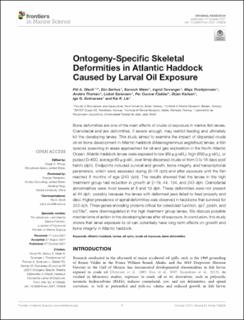| dc.contributor.author | Olsvik, Pål Asgeir | |
| dc.contributor.author | Sørhus, Elin | |
| dc.contributor.author | Meier, Sonnich | |
| dc.contributor.author | Torvanger, Ingrid | |
| dc.contributor.author | Thorbjørnsen, Maja | |
| dc.contributor.author | Thorsen, Anders | |
| dc.contributor.author | Sørensen, Lisbet | |
| dc.contributor.author | Fjelldal, Per Gunnar | |
| dc.contributor.author | Karlsen, Ørjan | |
| dc.contributor.author | Guimaraes, Igo G. | |
| dc.contributor.author | Lie, Kai Kristoffer | |
| dc.date.accessioned | 2021-11-29T13:19:35Z | |
| dc.date.available | 2021-11-29T13:19:35Z | |
| dc.date.created | 2021-11-24T12:46:22Z | |
| dc.date.issued | 2021 | |
| dc.identifier.citation | Frontiers in Marine Science. 2021, 8:726828 1-16. | en_US |
| dc.identifier.issn | 2296-7745 | |
| dc.identifier.uri | https://hdl.handle.net/11250/2831940 | |
| dc.description.abstract | Bone deformities are one of the main effects of crude oil exposure in marine fish larvae. Craniofacial and jaw deformities, if severe enough, may restrict feeding and ultimately kill the developing larvae. This study aimed to examine the impact of dispersed crude oil on bone development in Atlantic haddock (Melanogrammus aeglefinus) larvae, a fish species spawning in areas approached for oil and gas exploration in the North Atlantic Ocean. Atlantic haddock larvae were exposed to low (60 μg oil/L), high (600 μg oil/L), or pulsed (0–600, average 60 μg oil/L over time) dispersed crude oil from 0 to 18 days post hatch (dph). Endpoints included survival and growth, bone integrity, and transcriptional parameters, which were assessed during (0–18 dph) and after exposure until the fish reached 8 months of age (243 dph). The results showed that the larvae in the high treatment group had reduction in growth at 2–19, 44, 134, and 243 dph. Craniofacial abnormalities were most severe at 8 and 19 dph. These deformities were not present at 44 dph, possibly because the larvae with deformed jaws failed to feed properly and died. Higher prevalence of spinal deformities was observed in haddocks that survived for 243 dph. Three genes encoding proteins critical for osteoblast function, sp7, postn, and col10a1, were downregulated in the high treatment group larvae. We discuss possible mechanisms of action in the developing larvae after oil exposure. In conclusion, this study shows that larval exposure to oil can potentially have long-term effects on growth and bone integrity in Atlantic haddock. | en_US |
| dc.language.iso | eng | en_US |
| dc.publisher | Frontiers | en_US |
| dc.rights | Navngivelse 4.0 Internasjonal | * |
| dc.rights.uri | http://creativecommons.org/licenses/by/4.0/deed.no | * |
| dc.subject | bone deformities | en_US |
| dc.subject | crude oil exposure | en_US |
| dc.subject | oil spills | en_US |
| dc.subject | larvae | en_US |
| dc.subject | Atlantic haddock | en_US |
| dc.title | Ontogeny-Specific Skeletal Deformities in Atlantic Haddock Caused by Larval Oil Exposure | en_US |
| dc.type | Peer reviewed | en_US |
| dc.type | Journal article | en_US |
| dc.description.version | publishedVersion | en_US |
| dc.rights.holder | Copyright © 2021 Olsvik, Sørhus, Meier, Torvanger, Thorbjørnsen, Thorsen, Sørensen, Fjelldal, Karlsen, Guimaraes and Lie. This is an open-access article distributed under the terms of the Creative Commons Attribution License (CC BY). The use, distribution or reproduction in other forums is permitted, provided the original author(s) and the copyright owner(s) are credited and that the original publication in this journal is cited, in accordance with accepted academic practice. No use, distribution or reproduction is permitted which does not comply with these terms. | en_US |
| dc.source.pagenumber | 1-16 | en_US |
| dc.source.volume | 8 | en_US |
| dc.source.journal | Frontiers in Marine Science | en_US |
| dc.identifier.doi | 10.3389/fmars.2021.726828 | |
| dc.identifier.cristin | 1958368 | |
| dc.source.articlenumber | 726828 | en_US |
| cristin.ispublished | true | |
| cristin.fulltext | original | |
| cristin.qualitycode | 1 | |

